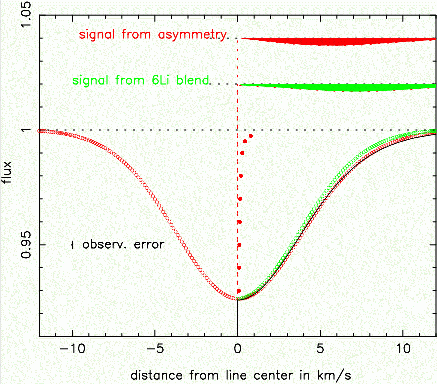Until recently, the value of the isotopic ratio 6Li/7Li was determined just for a few stars, and with a rather low confidence level (of the order of 2 sigma).
A dramatic increase on the number of such determinations occured last year, with the paper of Asplund, Lambert, Nissen al. 2006, reporting 6Li/7Li values for 24 metal-poor halo stars, most of them turn-off (TO) stars in the HR diagram. The result was far from expectations. As no 6Li is produced by the primordial nucleosynthesis, in a plot of 6Li abundance versus metallicity, it was expected to see a rise of 6Li, corresponding to the cosmic ray production, seen in the other light elements Be and B, even 7Li once its Cosmic Ray production has cought up its primordial production.
Instead of that, the 6Li abundance was found to be independent of metallicity, running parallel to the Spite plateau, from [Fe/H]= -2.7 to -1.25. If only values with a confidence better than 2 sigma are selected, the mean of 6Li/7Li is 0.044, with standard deviation of .012. Several groups have tried to explain this unexpected result, needing a new process. In particular Rollinde, Vangioni and Olive 2006, have considered a pregalactic fusion process alpha+alpha in accelerated metal-free supernova ejecta from primordial massive stars, having reionized the intergalactic matter, before the stellar nucleosynthesis had really started. Hubert Reeves (2007), and Jedamzik (2004) have explored other scenarios, the last one involving supersymmetric particles. However, Prantzos (2006) has pointed out severe energetic difficulties in these attempts, especially in view of the discrepancy between the cosmological abundance of 7Li derived from WMAP and the observed value of the Spite plateau, implying that much more 7Li and 6Li has been formed than what is observed.

The authors then decided to investigate a completeley different approach : to question the reality of the 6Li plateau. The motivation is that the 6Li blend occurs in the red wing of the much stronger 7Li feature. Line asymmetries are generated by convective motions in stellar atmospheres, especially when the convective zone reaches high photospheric levels, indeed the case for the metal-poor turn-off stars in which 6Li was found. Analyses with 1D models, ignore these asymmetries, and therefore, might use a wrong pseudo-continuum in measuring the 6Li absorption, in the wing of 7Li line.
The amount of line asymmetry in the metal-poor halo turn-off star HD 74000 was checked using a 20 hours exposure, taken with the spectrograph HARPS, mounted on the ESO La Silla 3.6m telescope. The choice of this spectrograph was motivated by its excellent accuracy in wavelength measurements. The S/N ratio per pixel is 600, typical of what is needed for 6Li measurement. As the line asymmetry for the 7Li resonance line is entangled with the presence of the 6Li blend, it is of course necessary to determine the asymmetry with other, unblended, lines, having as far as possible the same stratification as the Li resonance line, at 670.8 nm. Five iron lines were selected with a lower level nearly at the same distance in energy from the ionization level, and with equivalent widths similar to the components of the 7Li doublet.
The average of their profiles, rescaled to a common central depth, and convolved with the additional thermal broadening due to the lower mass of Li with respect to Fe, is shown in Figure 1 (red open circles). The asymmetry is materialized by the difference between the true red wing, and the symmetric of the blue wing (green circles). The signal corresponding to the asymmetry is shown, shifted for clarity to a continuum at ordinate 1.04. For comparison, the signal caused by a blend is shown, with an abundance ratio of .044, the one of the Asplund plateau, shifted to a 1.02 continuum. Clearly, there is a high level of degeneracy between these two signals. The main difference is the fact that the asymmetry is maximum at 6.1 km/s from the line center,whereas the 6Li blend signal is maximum at 7.14 km/s from the line center. In order to make this partial degeneracy more palpable, Figure 1 displays, as a continuous line, the red wing produced by the symmetric profile plus the blend. Although not coincident with the asymmetric profile with no 6Li, it is always within ± 1 sigma of the observational error from it, therefore practically indiscernible.
At this point, it can be concluded that the asymmetry does exist, and is large enough to mimic a 6Li blend at the level found by Asplund et al.(2006).
Next, this purely observational approach was checked by theory. For that, a non LTE 3D code was developed by M. Steffen and R. Cayrel on an hydrodynamical model computed by M. Steffen. with the CO5BOLD code (Freytag et al. 2002), corresponding to the effective temperature, gravity and metallicity of HD 74000. An asymmetry was found, very similar in shape to the result derived from our 5 Fe I line, only slightly less in amplitude. A big plus of the theoretical approach is that it has supplied, on top of a justification of the observe line asymmetry, a substantial line shift, observed but never explained before, now clearly connected with 3D hydrodynamical effects. The result for the 6Li/7Li ratio in HD74000 is 0. ± .0.02.
The conclusion is that line asymmetry route plays a major role in the determination of the 6Li/7Li ratio, and need to be investigated in more details, in particular its dependence upon effective temperature, gravity and metallicity.
Reference
- Line shift, line asymmetry and the 6Li/7Li isotopic ratio determination Roger Cayrel (GEPI, Obs-Paris), Matthias Steffen (AIP, Germany), Hum Chand (IAP, Paris), Piercarlo Bonifacio (GEPI, CIFIST, INAF-OAT), Monique Spite, François Spite (GEPI, Obs-Paris), Patrick Petitjean (IAP, Paris), Hans-Gunter Ludwig (GEPI, CIFIST), Elisabetta Caffau(GEPI, Obs-Paris) Astronomy & Astrophysics, Letter 2007, in press
Contact
- Roger Cayrel
(Observatoire de Paris, GEPI, & CNRS)

